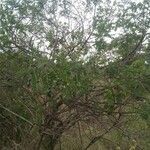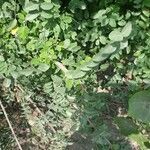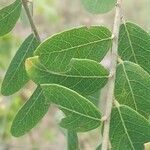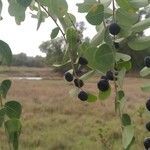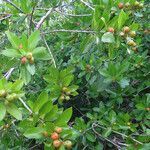Shrubs to 4 m tall, monoecious; branches brownish; young branchlets, leaves, and pedicels yellowish pubescent or puberulent or glabrous. Stipules subulate-lanceolate, brown, 1-3 mm, hard and spiny when dry; petiole 2-5 mm; leaf blade varying in shape, mostly elliptic to ovate, 1-5(-6.5) × 0.7-3 cm, membranous to papery, base obtuse to rounded, apex acute or obtuse to rounded; lateral veins 5-7 pairs, usually prominent on both surfaces. Inflorescence an axillary fascicle, rarely a cyme, with 2-10 male and 1 or 2 female flowers. Male flowers: pedicels delicate, 5-10 mm; sepals 5 or 6, in 2 series, ovate or obovate, unequal, 0.7-1.5 × 0.5-1.2 mm, entire; disk glands 5, scalelike, ca. 0.5 mm wide; stamens 5, erect, 3 with longer filaments coherent in a central column, 2 with shorter filaments, free; anthers triangular, longitudinally dehiscent. Female flowers: pedicels 4-8 mm, delicate; sepals 5 or 6, in 2 series, unequal, broadly ovate, 1-1.6 × 0.9-1.2 mm, puberulent inside at base; disk glands 5 or 6, oblong or obovate; ovary 4-12-celled, smooth; styles free, bifid at apex, lobes linear, revolute and connivent over top of ovary. Fruit a berry, globose to oblate, 4-6 mm wide, black and dark purplish at maturity, 4-12-celled, 8-16-seeded. Seeds trigonous, 1.6-2 mm, brown. Fl. Mar-Jun, fr. Jun-Oct. x = 13.
More
A shrub with many branches. Sometimes it is scrambling or a twiggy tree. It can be 2-8 m high and spread 1.5-3 m wide. The branches hang over. The leaves are oval and 2.5 cm long by 1.5 cm wide. They are arranged to look like a compound leaf. The veins under the leaf are red and net-like. The flowers are very small and in the axils of leaves. They are clustered on short slender branches. Male and female flowers occur together in clusters in the axils of leaves. The fruit is berry-like and reddish but black when mature. They are 4-6 mm across. The seeds are reddish.
Scandent shrub, up to 4 m high. Branchlets smooth or very slightly verrucose. Flowering branchlets produced in axil of flowerless leafy shoot. Leaves oblong or elliptic. Flowers yellowish red.
A tropical plant. It grows in tropical Africa and Asia. It grows in low altitude forest near rivers. In Nepal it grows up to about 800 m altitude. In tropical Australia it grows from sea level to 950 m altitude. In Pakistan it grows in lowland areas, often near the sea and in areas subject to flooding. In Zimbabwe it grows in hot, dry deciduous woodland between 610-1,370 m above sea level. It can grow in arid places.
More
Often forming thickets on floodplain grassland; sand dune scrub; littoral scrub and dune forest; rain-forest; mixed deciduous woodlands and scrub; occasionally on termitaria; miombo woodlands; often beside seasonal rivers and streams.
